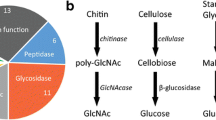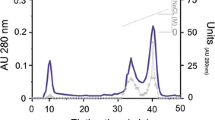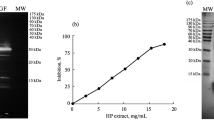Abstract
Aspartic proteinases in the gastric fluid of clawed lobsters Homarus americanus and Homarus gammarus were isolated to homogeneity by single-step pepstatin-A affinity chromatography; such enzymes have been previously identified as cathepsin D-like enzymes based on their deduced amino acid sequence. Here, we describe their biochemical characteristics; the properties of the lobster enzymes were compared with those of its homolog, bovine cathepsin D, and found to be unique in a number of ways. The lobster enzymes demonstrated hydrolytic activity against synthetic and natural substrates at a wider range of pH; they were more temperature-sensitive, showed no changes in the K M value at 4°C, 10°C, and 25°C, and had 20-fold higher k cat /K M values than bovine enzyme. The bovine enzyme was temperature-dependent. We propose that both properties arose from an increase in molecular flexibility required to compensate for the reduction of reaction rates at low habitat temperatures. This is supported by the fast denaturation rates induced by temperature.




Similar content being viewed by others
References
Ahsan MN, Watabe S (2001) Kinetic and structural properties of two isoforms of trypsin isolated from the viscera of Japanese anchovy, Engraulis japonicus. J Protein Chem 20:49–58
Andreeva NS (1992) Some aspects of structural studies on aspartic proteinases. Scand J Clin Lab Invest 52:31–38
Aoki H, Ahsan MN, Watabe S (2003) Molecular cloning and functional characterization of crustapain: a distinct cysteine proteinase with unique substrate specificity from Northern shrimp Pandalus borealis. J Biochem 133:799–810
Aoki H, Ahsan M, Watabe S (2004) Molecular and enzymatic properties of a cathepsin L-like proteinase with distinct substrate specificity from northern shrimp (Pandalus borealis). J Comp Physiol B 174:59–69
Barrett AJ (1979) Cathepsin D: the lysosomal aspartic proteinase. CIBA Found Symp 79:37–50
Barrett AJ, Rawlings ND, Woessner JF (1998) Proteolytic enzymes. In: Barrett AJ, Rawlings ND, Woessner JF (eds) Handbook of proteolytic enzymes. Academic, San Diego, pp 801–805
Benes P, Vetvicka V, Fusek M (2008) Cathepsin D—many functions of one aspartic protease. Crit Rev Oncol Hematol 68:12–28
Boldbaatar D, Sikasunge CS, Battsetseg B, Xuan X, Fujisaki K (2006) Molecular cloning and functional characterization of an aspartic protease from the hard tick Haemaphysalis longicornis. Insect Biochem Mol Biol 36:25–36
Brindley PJ, Kalinna BH, Wong JYM, Bogitsh BJ, King LT, Smyth DJ, Verity CK, Abbenante G, Brinkworth RI, Fairlie DP, Smythe ML, Milburn PJ, Bielefeldt-Ohmann H, Zheng Y, McManus DP (2001) Proteolysis of human hemoglobin by schistosome cathepsin D. Mol Biochem Parasitol 112:103–112
Brinkworth RI, Prociv P, Loukas A, Brindley PJ (2001) Hemoglobin-degrading, aspartic proteases of blood-feeding parasites. J Biol Chem 276:38844–38851
Carginale V, Trinchella F, Capasso R, Parisia E (2004) Gene amplification and cold adaptation of pepsin in Antarctic fish: a possible strategy for food digestion at low temperature. Gene 336:195–205
Cobb JS, Phillips BF (1980) The biology and management of lobsters. Academic, New York
Córdova-Murueta JH, García-Carreño FL, Navarrete-del-Toro MDLA (2003) Digestive enzymes present in crustacean feces as a tool for biochemical, physiological, and ecological studies. J Exp Mar Biol Ecol 297:43–56
D'Amico S, Claverie P, Collins T, Georlette D, Gratia E, Hoyoux A, Meuwis M-A, Feller G, Gerday C (2002) Molecular basis of cold adaptation. Phil Trans Biol Sci 357:917–925
Davies DR (1990) The structure and function of the aspartic proteinases. Annu Rev Biophys Biophys Chem 19:189–215
Delcroix M, Sajid M, Caffrey C, Lim K, Jan D, Hsieh I, Bahgat M, Dissous C, McKerrow J (2006) A multienzyme network functions in intestinal protein digestion by a platyhelminth parasite. J Biol Chem 281:39316–39329
Feller G, Gerday C (1997) Psychrophilic enzymes: molecular basis of cold adaptation. Cell Mol Life Sci 53:830–841
Feller G, Gerday C (2003) Psychrophilic enzymes: hot topics in cold adaptation. Nat Rev Microbiol 1:200–208
Feller G, Narinx E, Arpigny JL, Aittaleb M, Baise E, Genicot S, Gerday C (1996) Enzymes from psychrophilic organisms. FEMS Microbiol Rev 18:189–202
Fields PA (2001) Review: protein function at thermal extremes: balancing stability and flexibility. Comp Biochem Physiol A Mol Integr Physiol 129:417–431
Galgani F, Benyamin Y, van Wormhoudt A (1985) Purification, properties and immunoassay of trypsin from Penaeus japonicus. Comp Biochem Physiol B 81:447–452
Gerday C, Aittaleb M, Bentahir M, Chessa J-P, Claverie P, Collins T, D'Amico S, Dumont J, Garsoux G, Georlette D, Hoyoux A, Lonhienne T, Meuwis MA, Feller G (2000) Cold-adapted enzymes: from fundamentals to biotechnology. Trends Biotechnol 18:103–107
Goldberg DE, Slater AF, Beavis R, Chait B, Cerami A, Henderson GB (1991) Hemoglobin degradation in the human malaria pathogen Plasmodium falciparum: a catabolic pathway initiated by a specific aspartic protease. J Exp Med 173:961–969
Gudmundsdóttir Á, Pálsdóttir HM (2005) Atlantic cod trypsins: from basic research to practical applications. Mar Biotechnol 7:77–88
Gui Z, Lee K, Kim B, Choi Y, Wei Y, Choo Y, Kang P, Yoon H, Kim I, Je Y, Seo S, Lee S, Guo X, Sohn H, Jin B (2006) Functional role of aspartic proteinase cathepsin D in insect metamorphosis. BMC Dev Biol 6:49–60
Harrop SA, Prociv P, Brindley PJ (1996) Acasp, a gene encoding a cathepsin D-like aspartic protease from the hookworm Ancylostoma caninum. Biochem Biophys Res Commun 227:294–302
Hernández-Cortés P, Whitaker JR, García-Carreño FL (1997) Purification and characterization of chymotrypsin from Penaeus vannamei (Crustacea: Decapoda). J Food Biochem 21:497–514
Hernández-Cortés P, Cerenius L, García-Carreño FL, Soderhal K (1999) Trypsin from Pacifastacus leniusculus hepatopancreas: purification and cDNA cloning of the synthesized zymogen. Biol Chem 380:499–501
Hofer R, Ladurner H, Gattringer A, Wieser W (1975) Relationship between the temperature preference of fishes, amphibians and reptiles, and the substrate affinities of their trypsins. J Comp Physiol B 99:345–355
Hu KJ, Leung PSC (2007) Food digestion by cathepsin L and digestion-related rapid cell differentiation in shrimp hepatopancreas. Comp Biochem Physiol 146B:69–80
Khan AR, James MNG (1998) Molecular mechanisms for the conversion of zymogens to active proteolytic enzymes. Prot Sci 7:815–836
Khan AR, Khazanovich-Bernstein N, Bergmann EM, James MNG (1999) Structural aspects of activation pathways of aspartic protease zymogens and viral 3 C protease precursors. Proc Natl Acad Sci USA 96:10968–10975
Klein B, Sellos D, Van Wormhoudt A (1998) Genomic organisation and polymorphism of a crustacean trypsin multi-gene family. Gene 216:123–129
Knight G, Barrett AJ (1976) Interaction of human cathepsin D with the inhibitor pepstatin. Biochem J 155:117–125
Laycock MV, Hirama T, Hasnain S, Watson D, Storer A (1989) Purification and characterization of a digestive cysteine proteinase from the American lobster (Homarus americanus). Biochem J 263:439–444
Le Boulay C, van Wormhoud A, Sellos D (1995) Molecular cloning and sequencing of two cDNAs encoding cathepsin L-related cysteine proteinases in the nervous system and in the stomach of the Norway lobster (Nephrops norvegicus). Comp Biochem Physiol B 111:353–359
Le Boulay C, Sellos D, Van Wormhoudt A (1998) Cathepsin L gene organization in crustaceans. Gene 218:77–84
Lee PG, Smith LL, Lawrence AL (1984) Digestive protease of Penaeus vannamei Boone: relationship between enzyme activity, size and diet. Aquaculture 42:225–239
Leiros HK, Willassen NP, Smalås AO (2000) Structural comparison of psychrophilic and mesophilic trypsins. Elucidating the molecular basis of cold-adaptation. Eur J Biochem 267:1039–1049
Matsumoto I, Asakura T, Ohmori T, Tamura K (2009) Cathepsin D-like aspartic proteinase occurring in a maize weevil, Sitophilus zeamais, as a candidate digestive enzyme. Biosci Biotechnol Biochem 73:2338–2340
Metcalf P, Fusek M (1993) Two crystal structures for cathepsin D: the lysosomal targeting signal and active site. EMBO J 12:1293–1302
Muhlia-Almazan A, García-Carreño FL (2002) Influence of molting and starvation on the synthesis of proteolytic enzymes in the midgut gland of the white shrimp Penaeus vannamei. Comp Biochem Physiol B 133:383–394
Mukhin V, Smirnova E, Novikov V (2007) Peculiarities of digestive function of proteinases in invertebrates—inhabitants of cold seas. J Evol Biochem Physiol 43:476–482
Navarrete del Toro MA, García-Carreño FL, Díaz LM, Celis-Guerrero L, Saborowski R (2006) Aspartic proteinases in the digestive tract of marine decapod crustaceans. J Exp Zool 305A:645–654
Padilha MHP, Pimentel AC, Ribeiro AF, Terra WR (2009) Sequence and function of lysosomal and digestive cathepsin D-like proteinases of Musca domestica midgut. Insect Biochem Mol Biol 39:782–791
Pardesi SR, Dandekar SP, Jamdar SN, Harikumar P (2004) Identification and purification of an aspartic proteinase from human semen. Indian J Clin Biochem 19:84–90
Perera E, Moyano FJ, Díaz M, Perdomo-Morales R, Montero-Alejo V, Alonso E, Carrillo O, Galich GS (2008) Polymorphism and partial characterization of digestive enzymes in the spiny lobster Panulirus argus. Comp Biochem Physiol B 150:247–254
Pinho RT, Beltramini LM, Alves CR, De-Simone SG (2009) Trypanosoma cruzi: isolation and characterization of aspartyl proteases. Exp Parasitol 122:128–133
Ranjit N, Zhan B, Hamilton B, Stenzel D, Lowther J, Pearson M, Gorman J, Hotez P, Loukas A (2009) Proteolytic degradation of hemoglobin in the intestine of the human hookworm Necator americanus. J Infect Dis 199:904–912
Rojo L, Muhlia-Almazán A, Saborowski R, García Carreño FL (2010a) Aspartic cathepsin D endopeptidase contributes to extracellular digestion in clawed lobsters Homarus americanus and Homarus gammarus. Mar Biotechnol 12:696–707
Rojo L, Sotelo-Mundo R, García-Carreño F, Gráf L (2010b) Isolation, biochemical characterization, and molecular modeling of American lobster digestive cathepsin D1. Comp Biochem Physiol B 157:394–400
Sainz JC, García-Carreño FL, Cordova-Murueta J, Cruz-Hernández P (2004a) Whiteleg shrimp (Litopenaeus vannamei, Boone, 1931) isotrypsins: their genotype and modulation. J Exp Mar Biol Ecol 326:105–113
Sainz JC, García-Carreño FL, Sierra-Beltran A, Hernandez-Cortés P (2004b) Trypsin synthesis and storage as zymogen in the midgut gland of the shrimp Litopenaeus vannamei. J Crustacean Biol 24:266–273
Siddiqui KS, Cavicchioli R (2006) Cold-adapted enzymes. Annu Rev Biochem 75:403–433
Simões I, Faro C (2004) Structure and function of plant aspartic proteinases. Eur J Biochem 271:2067–2075
Simpson BK, Haard NF (1987) Cold-adapted enzymes from fish. In: Knorr D (ed) Food Biotechnology. Marcel Dekker, New York, pp 495–527
Smalås AO, Heimstad ES, Hordvik A, Willassen NP, Male R (1994) Cold adaption of enzymes: structural comparison between salmon and bovine trypsins. Protein Struct Funct Genet 20:149–166
Sojka D, Franta Z, Horn M, Hajdusek O, Caffrey C, Mares M, Kopacek P (2008) Profiling of proteolytic enzymes in the gut of the tick Ixodes ricinus reveals an evolutionarily conserved network of aspartic and cysteine peptidases. Parasit Vectors 1:7–21
Stoll VS, Blanchard JS (1990) Buffers: principles and practice. In: Burgess RR, Deutscher MP (eds) Methods in enzymology. Academic, New York, pp 24–38
Suttiprapa S, Mulvenna J, Huong NT, Pearson MS, Brindley PJ, Laha T, Wongkham S, Kaewkes S, Sripa B, Loukas A (2009) Ov-APR-1, an aspartic protease from the carcinogenic liver fluke, Opisthorchis viverrini: functional expression, immunolocalization and subsite specificity. Int J Biochem Cell Biol 41:1148–1156
Szecsi PB (1992) The aspartic proteases. Scand J Clin Lab Invest 52:5–22
Takahashi T, Tang J (1981) Cathepsin D from porcine and bovine spleen. In: Lorand L (ed) Methods in enzymology. Academic, New York, pp 565–581
Williamson AL, Brindley PJ, Abbenante G, Prociv P, Berry C, Girdwood K, Pridchard DI, Fairlie DP, Hotez P, Dalton JP, Loukas A (2002) Cleavage of hemoglobin by hookworm cathepsin D aspartic proteases and its potential contribution to host specificity. FASEB J 16:1458–1460
Williamson AL, Brindley PJ, Abbenante G, Datu B, Prociv P, Berry C, Girdwood K, Pritchard DI, Fairlie DP, Hotez PJ, Zhan B, Loukas A (2003a) Hookworm aspartic protease, Na-APR-2, cleaves human hemoglobin and serum proteins in a host-specific fashion. J Infect Dis 187:484–494
Williamson AL, Brindley PJ, Knox DP, Hotez PJ, Loukas A (2003b) Digestive proteases of blood-feeding nematodes. Trends Parasitol 19:417–423
Yasuda Y, Kageyama T, Akamine A, Shibata M, Kominami E, Uchiyama Y, Yamamoto K (1999) Characterization of new fluorogenic substrates for the rapid and sensitive assay of cathepsin E and cathepsin D. J Biochem 125:1137–1143
Zar JH (1984) Biostatistical analysis. Prentice-Hall, Englewood Cliffs, N.J
Zecchinon L, Claverie P, Collins T, D'Amico S, Delille D, Feller G, Georlette D, Gratia E, Hoyoux A, Meuwis M-A, Sonan G, Gerday C (2001) Did psychrophilic enzymes really win the challenge? Extremophiles 5:313–321
Acknowledgments
We thank Julio Cordoba and Patricia Hernandez for technical guidance. Ira Fogel provided editorial comments. The project was funded by Consejo Nacional de Ciencia y Tecnología (CONACYT grant: 80935). L. R. was a recipient of a CONACYT doctoral fellowship (#200577).
Author information
Authors and Affiliations
Corresponding author
Rights and permissions
About this article
Cite this article
Rojo, L., García-Carreño, F. & de los Angeles Navarrete del Toro, M. Cold-Adapted Digestive Aspartic Protease of the Clawed Lobsters Homarus americanus and Homarus gammarus: Biochemical Characterization. Mar Biotechnol 15, 87–96 (2013). https://doi.org/10.1007/s10126-012-9461-4
Received:
Accepted:
Published:
Issue Date:
DOI: https://doi.org/10.1007/s10126-012-9461-4




